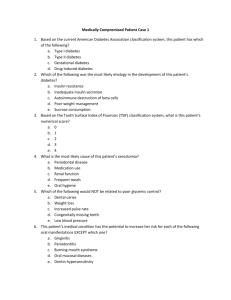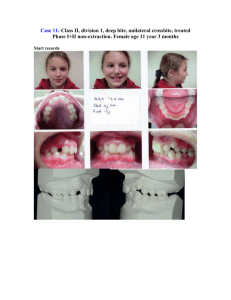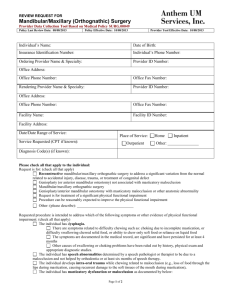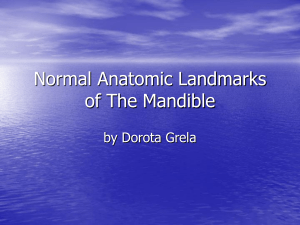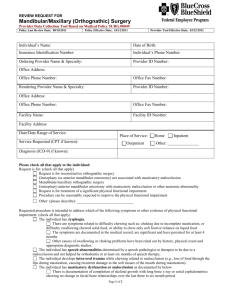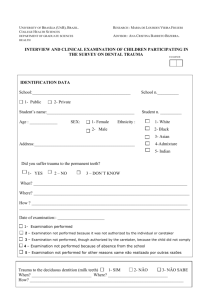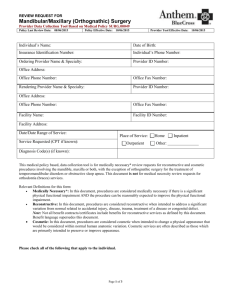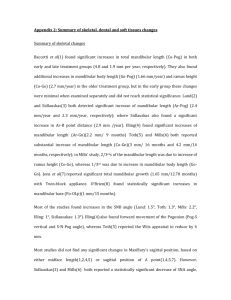File
advertisement
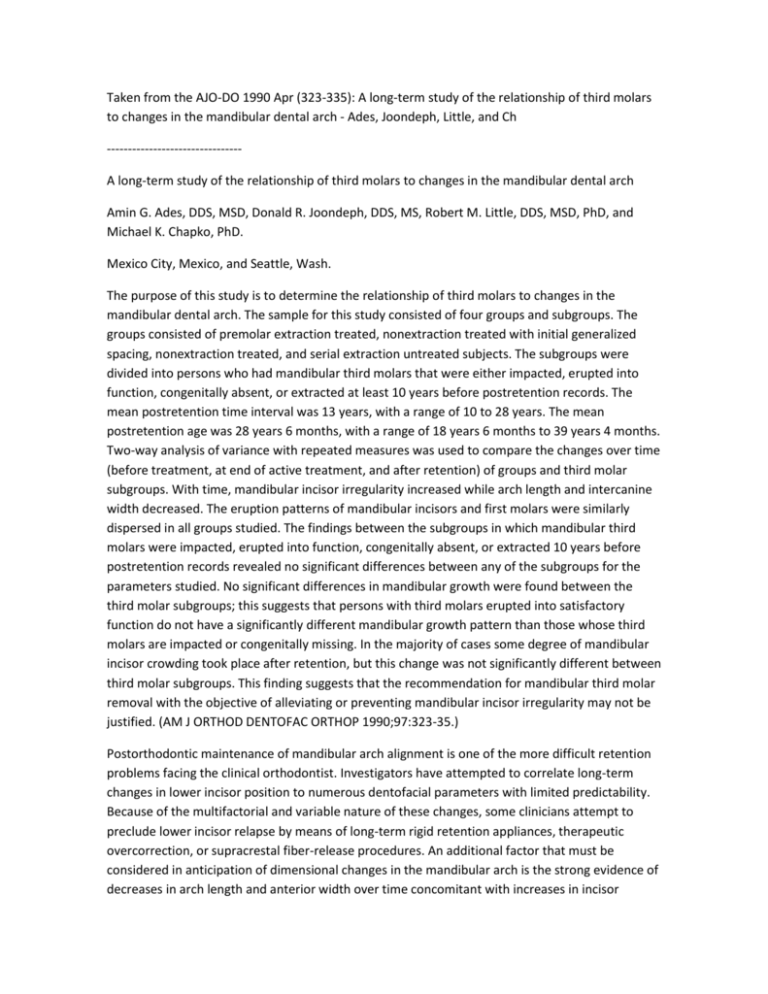
Taken from the AJO-DO 1990 Apr (323-335): A long-term study of the relationship of third molars to changes in the mandibular dental arch - Ades, Joondeph, Little, and Ch -------------------------------A long-term study of the relationship of third molars to changes in the mandibular dental arch Amin G. Ades, DDS, MSD, Donald R. Joondeph, DDS, MS, Robert M. Little, DDS, MSD, PhD, and Michael K. Chapko, PhD. Mexico City, Mexico, and Seattle, Wash. The purpose of this study is to determine the relationship of third molars to changes in the mandibular dental arch. The sample for this study consisted of four groups and subgroups. The groups consisted of premolar extraction treated, nonextraction treated with initial generalized spacing, nonextraction treated, and serial extraction untreated subjects. The subgroups were divided into persons who had mandibular third molars that were either impacted, erupted into function, congenitally absent, or extracted at least 10 years before postretention records. The mean postretention time interval was 13 years, with a range of 10 to 28 years. The mean postretention age was 28 years 6 months, with a range of 18 years 6 months to 39 years 4 months. Two-way analysis of variance with repeated measures was used to compare the changes over time (before treatment, at end of active treatment, and after retention) of groups and third molar subgroups. With time, mandibular incisor irregularity increased while arch length and intercanine width decreased. The eruption patterns of mandibular incisors and first molars were similarly dispersed in all groups studied. The findings between the subgroups in which mandibular third molars were impacted, erupted into function, congenitally absent, or extracted 10 years before postretention records revealed no significant differences between any of the subgroups for the parameters studied. No significant differences in mandibular growth were found between the third molar subgroups; this suggests that persons with third molars erupted into satisfactory function do not have a significantly different mandibular growth pattern than those whose third molars are impacted or congenitally missing. In the majority of cases some degree of mandibular incisor crowding took place after retention, but this change was not significantly different between third molar subgroups. This finding suggests that the recommendation for mandibular third molar removal with the objective of alleviating or preventing mandibular incisor irregularity may not be justified. (AM J ORTHOD DENTOFAC ORTHOP 1990;97:323-35.) Postorthodontic maintenance of mandibular arch alignment is one of the more difficult retention problems facing the clinical orthodontist. Investigators have attempted to correlate long-term changes in lower incisor position to numerous dentofacial parameters with limited predictability. Because of the multifactorial and variable nature of these changes, some clinicians attempt to preclude lower incisor relapse by means of long-term rigid retention appliances, therapeutic overcorrection, or supracrestal fiber-release procedures. An additional factor that must be considered in anticipation of dimensional changes in the mandibular arch is the strong evidence of decreases in arch length and anterior width over time concomitant with increases in incisor irregularity. This study will attempt to determine the role mandibular third molars play in these long-term dental changes. REVIEW OF THE LITERATURE The role of third molars in postorthodontic tooth alignment was described quite early in the literature by Dewey1 who, in 1917, commented that "in some cases the mandibular third molar will become impacted due to the lack of space, in others it creates space for eruption by causing the anterior teeth to crowd." since that time, numerous investigators have attempted to determine whether such a correlation exists. Bergstrom and Jensen2 studied sixty subjects with unilateral molar agenesis and noted greater crowding in the quadrants in which third molars were present than in those in which third molars were missing. In an investigation of 49 patients a mean of 66 months after orthodontic therapy, Sheneman3 concluded that patients with third molars congenitally missing showed greater dental stability than those in whom third molars were present. The sample included eleven patients with third molars in bilateral occlusion, thirty-one patients with bilateral third molar impaction, and seven patients with bilateral third molar agenesis. Schwartz4 compared changes in first permanent molar position between a group of 56 patients who had third molar tooth germs removed and a group of 49 patients in whom third molars were completely developed. He found a significantly greater forward movement of the first molars, particularly in the mandibular arch, in the group without third molar extraction and concluded that the more frequent crowding of mandibular incisors in this group was a result of the sagittal force exerted by the presence of third molars. Lindquist and Thilander5 evaluated a sample of 23 males and 29 females with bilateral mandibular impaction of third molars. The impacted third molar was removed on one side, and the contralateral quadrant was used as a control. The average age at the time of extraction was 15 years 5 months, with a range of 13 to 19 years. With the use of study models and cephalograms (lateral, forward, and oblique), the sample was evaluated annually up to 3 years after extraction. Although they found evidence of less crowding on the extraction side, in 70% of the patients the investigators were not able to use their analysis of variables to predict which persons would react favorably. Several investigators have published data that suggest third molars play very little, if any, role in long-term dental arch changes. In a longitudinal study of 29 persons between the ages of 14 and 20 who had not been orthodontically treated, Stemm6 found that the presence or absence of third molars was not a significant factor in changes in mandibular arch width, arch length, or tooth rotation. Shanley7 found no significant differences between groups when he evaluated lower incisor crowding and procumbency in a total of 44 patients with third molars either impacted, erupted, or congenitally absent. In a longitudinal study of 61 pairs of twins observed at 12 to 15 years of age and again at the age of 26 to 30 years, Lundstrom8 found a reduction of spacing with an increase in crowding with age, but he found no relationship between third molar agenesis and these observed changes in arch dimension. In 1973 Kaplan9,10 studied postretention crowding in a group of 75 orthodontically treated patients. He found that, although some degree of lower incisor crowding occurred in the majority of patients, it was not significantly different in subjects whose mandibular third molars were bilaterally erupted, impacted, or congenitally absent. In addition, he found that changes in mandibular arch length, width, and molar and incisor position were not significantly different among the three groups. In conclusion, Kaplan stated that the presence of third molars does not influence postretention changes in arch dimension, tooth position, or mandibular incisor crowding. In a critical review of Kaplan's article, Schulhof11 pointed out that perhaps with a larger sample and different statistical tests Kaplan might have found significant differences between his groups. Richardson12,13 found significant mesial movement of first molars between the ages of 13 and 17 years in a group of 51 subjects with intact lower arches. This forward movement was correlated with an increase in mandibular arch crowding that occurred over the same time period. However, she found no difference in the amount of mesial first molar movement in persons with impacted third molars as compared with subjects whose third molars were not impacted. At present there is no unanimity of opinion or conclusive experimental evidence of the role of third molars in mandibular incisor stability. A review of the literature reveals the need for further evaluation over increased postretention intervals with samples of larger size. MATERIALS AND METHODS The sample for this study consisted of pretreatment, posttreatment, and postretention study models and lateral cephalometric radiographs of 97 patients from the files of the graduate orthodontic clinic at the University of Washington and from the private practices of Drs. Richard Riedel, Alton Moore, and George McCulloch. The subjects were selected on the basis of meeting the requirements of one of the following four subgroups relative to the mandibular third molars(M3): Subgroup M3ER (n = 32). Both lower third molar erupted to the occlusal plane with no marginal ridge discrepancies greater than 1.0 mm, in good alignment buccolingually (no crossbite), and of normal size and form. Subgroup M3IM (n = 14). Bilaterally impacted M3. Impaction was defined as incomplete eruption of M3 because of its inclined position relative to the second molar or the ascending ramus, or a vertical position whereby eruption was impeded by soft tissue and lack of space. This sample was selected on the basis of the patient's age and the completion of M3 root development. Subgroup M3AG (n = 17). Bilateral M3 agenesis. The diagnosis of M3 agenesis was based on the examination of all radiographs taken throughout the treatment period and at the postretention examination and a negative history of previous third molar extractions. Subgroup M3EX (n = 34). Bilateral extraction of M3 at least 10 years before postretention records but after completion of active treatment. An examination of all radiographs revealed intrabony impactions of all third molars before extraction. For all subgroups, the following selection criteria were applied: (1) subjects free of all retention for at least 10 years; (2) pretreatment, posttreatment, and postretention study models and lateral cephalometric radiographs present; (3) subjects' posttreatment records taken no more than 9 months after treatment was completed; (4) lateral cephalograms and study models for a given time period not more than 6 months apart; (5) no fixed appliances evident on the pretreatment or posttreatment cephalograms and study models (except molar bands or mandibular canine bands for retainer stabilization); (6) all subjects white; (7) posttreatment alignment of mandibular incisors acceptable (irregularity index less than 3.5 as described by Little14); (8) no fiber release procedure performed on any teeth15; (9) no deciduous teeth present on the posttreatment casts; (10) mandibular growth essentially completed by the postretention period. The sample in summarized in Table I. Forty-two subjects had Angle Class I, 41 subjects had Angle Class II, Division 1, and 14 subjects had Angle Class II, Division 2 occlusions. No Angle Class III subjects were included. In 55 patients first or second premolars were extracted as part of the orthodontic therapy; asymmetric extraction sequences were not included. Eighteen nonextraction subjects had generalized spacing before treatment and underwent subsequent orthodontic treatment. Eleven nonextraction patients had no pretreatment generalized spacing and underwent subsequent orthodontic treatment. The nonextraction patients were divided into two groups on the basis of initial arch length assessment (nonextraction with generalized spacing and with no space). Thirteen patients had early serial extraction of first premolars with no subsequent orthodontic treatment. All extraction and nonextraction patients were treated with a multibanded edgewise technique except those who had serial extraction of first premolars with no subsequent treatment. The mean postretention time was 13 years, with a range of 10 to 28 years. The mean postretention age was 28 years 6 months, with a range of 18 years 6 months to 39 years 4 months (Table II). Model analysis Helios calipers with fine tips measuring within 0.10 mm were used by one person to measure the following at T1, T2, and T3, as described by Little.14 Irregularity index. Sum of the distances between five anatomic contact points of the mandibular six anterior teeth (Fig. 1). Mandibular intercanine width. The distance between cusp tips or estimated cusp tips in cases of wear facets (Fig. 1). Mandibular arch length. The sum of the right and left distances from mesial anatomic contact points of first permanent molars to the contact point of the central incisors or to the midpoint between the central incisor contacts, if spaced (Fig. 1). Overbite. Mean overlap of maxillary to mandibular central incisors. Overjet. The distance parallel to the occlusal plane from the incisal edges of the most labial maxillary to the most labial mandibular central incisor. Cephalometric analysis The cephalometric radiographs were traced by a single technician on acetate paper by a method similar to that described by Little.16 The overall superimposition was constructed by "best fit" technique of the ethmoid triad: planum sphenoidum, sphenoid registration point, and greater wings of the sphenoid (Fig. 2). The x axis for the Cartesian coordinate system was determined by construction of a line from porion to orbitale (Frankfort horizontal plane). The y axis was constructed by scribing of a perpendicular line to the x axis at cranial base registration point, which lies midway between the greater wings of the sphenoid bone where they cross the sphenoid plane-cribriform plate contour.17 Mandibular superimposition was performed by Bjork's technique of natural structures: (1) the lingual internal cortical architecture of the symphysis, (2) the mandibular canal, and (3) the inferior contour of the mandibular third molar buds before root formation.18 The initial occlusal plane represented the x axis in the mandibular superimposition, and a perpendicular line tangent to a point midway between the mesial surfaces of the right and left mandibular first molars represented the y axis. The point of intersection of the x and y axes (i.e., the origin of the x-y coordinate system) represented the mandibular first molar at Tl (Fig. 3). These two x-y coordinate systems gave vertical and horizontal components to the points representing the cranial base, mandible, and mandibular denture. On each tracing the cephalometric landmarks at T1, T2, and T3 were located and indicated by points digitized with a digital converter. The digitizer converted the analog information into a digital form for computer analysis. Statistical analysis Two-way analysis of variance with repeated measures was used to compare the changes over time (pretreatment, end of active treatment, and postretention) of groups (extraction treated, nonextraction with generalized spacing treated, nonextraction treated, and first premolar serial extraction nontreated) or subgroups (third molar impacted [M3IM], third molar erupted [M3ER], third molar agenesis [M3AG], and third molar extracted [M3EX]). Measurement error To reduce examiner bias, each study model was numbered and subsequently measured in random order by means of a computer-generated list. Measurement error was evaluated by random selection of 21 casts, each measured on three separate occasions. The mean error in assessment of irregularity was ±0.30 mm, whereas arch width, length, overbite, and overjet ranged from 0.11 to 0.19 mm. To assess measurement error in the tracing and digitizing techniques, ten cephalograms were randomly selected, traced, and digitized on two separate occasions by calculation of the University of Washington analysis variables.16 When the same ten tracings were digitized twice, the mean correlation between the two measurements was 0.99. When the same ten head films were traced and digitized twice, the mean correlation between the two measurements was 0.93. The mean error in linear measurements was ± 0.8 mm. The mean error in angular measurements was ± 1.7°. RESULTS The sample for this study was divided into four groups and subgroups. The groups consisted of premolar extraction treated, nonextraction treated with generalized spacing, nonextraction treated, and serial extraction untreated. The subgroups were divided into persons whose mandibular third molars were either impacted, erupted into function, congenitally absent, or extracted at least 10 years before postretention records. Comparisons were made within the groups and subgroups. The reader should note the amount of standard deviation for some of the parameters studied, which indicates the large degree of variation between individuals. Group comparisons Mandibular anterior irregularity (II). Mandibular anterior irregularity decreased significantly during treatment (X:– 3 .6 ± SD 4.0 mm; p£ 0.01) for the entire sample. There was a significant posttreatment relapse (X: +2.3 ± 1.9 mm; p£ 0.01). The net improvement was a mere 33% for the sample as a whole but varied according to extraction versus nonextraction treatment. As expected, the patients with crowding treated with premolar extraction exhibited a significantly greater degree of decrease in mandibular anterior irregularity (X: – 5.01 ± 4.2 mm) during treatment than the nonextraction or serial extraction groups (p£ 0.01). During the postretention phase the premolar-extraction group underwent greater relapse (X: + 2.4 ± 2.1 mm), than the other groups (p£ 0.01). No significant differences in mandibular incisor irregularity at T3 were found between groups; the irregularity scores ranged from 3.4 ± 1.2 mm to 4.5 ± 2.6 mm. Intercanine width (WID). Intercanine width was increased slightly during treatment (X: + 0.6 ± 1.9 mm) but decreased beyond its original dimension during the postretention interval (X: – 1.7 ± 1.4 mm, p£ 0.01), resulting in a net decrease in arch width in the canine area from before treatment to after retention. Arch length (AL). Arch length decreased significantly in all groups over time, but no significant differences were noted between groups. Overbite and overjet (OB + OJ). Overbite and overjet were decreased during the treatment period (X: – 1.6 ± 1.6 mm) (X: 0.6 ± 1.2 mm), resulting in a net decrease in both overbite and overjet. From before treatment to after retention, overbite showed a net reduction of 55% (X: – 0.9 ± 1.6 mm) while overjet showed a 73% net improvement (X: – 2 ± 2.8 mm). Mandibular incisor and first molar position. Mandibular incisors were retracted during treatment (X: – 1.1° ± 7°; X: – 1.5 ± 2.2 mm; p£ 0.05) but proclined approximately the same amount after treatment so that the overall result was a return toward the original axial inclination (X: +0.7° ± 5.5°; X: +0.5 ± 1.8 mm). The mandibular first molar responded similarly, uprighting during treatment (X: – 2.8° ± 2.2°; p£ 0.05) and slightly proclining during the posttreatment interval (X: + 1.0° ± 1.2°; p£ 0.05). Mandibular length. All groups demonstrated an increase in mandibular length from before treatment to after retention (X: + 10.05 ± 6.9 mm; p£ 0.01). However, the absolute length of the mandible (Ar-Pg) was greater (+ 4.9 mm; p£ 0.01) in the nonextraction generalized spacing group than in the remaining groups when measured at the pretreatment and postretention intervals. There was no difference between groups, however, in the amount of mandibular growth that took place during the time interval studied. In addition, evaluation of mandibular growth direction revealed no significant differences in vertical or horizontal growth between groups. Third molar subgroup comparisons Comparison between the subgroups in which mandibular third molars were impacted, erupted into function, congenitally absent, or extracted 10 years before postretention records revealed no significant differences between any of the subgroups in the following parameters studied: mandibular incisor irregularity, intercanine width, arch length, overbite and overjet, and mandibular incisor and first molar eruption patterns ( Fig. 4, Table III). In addition, there were no significant differences in amount of mandibular growth, absolute mandibular length, or mandibular growth direction between third molar subgroups. DISCUSSION The extraction-treated group showed a net long-term improvement in incisor irregularity of only 40%. This finding is consistent with the data of Little et al.,19 who stated that success at maintaining satisfactory mandibular anterior alignment is less than 30% in patients whose first premolars have been extracted. The changes in intercanine width are in agreement with the observations of Sinclair et al.17 that intercanine width decreases over time in untreated persons and with studies by Amott,20 Arnold,21 Welch,22 Shapiro,23 Lombardi,24 and Kaplan9,10 on treated persons. Although the nonextraction group with generalized spacing showed these same changes with time, the absolute intercanine width measurement at each time interval was, on the average, 1 mm greater than in the other three groups. Although this finding was statistically significant, other factors such as differences in tooth size between groups could be etiologic factors. Further studies with large sample sizes should be evaluated to quantify such differences in anterior arch dimension. The arch length findings are in agreement with previous studies by Shapiro,23 Kaplan,9,10 and Little et al.,19 who documented long-term decreases in arch length in treated persons, and the findings of Sinclair et al.17 in untreated persons with normal occlusions. In addition, the present findings are in agreement with those of Little et al.,19 who found similar overbite and overjet changes through time in patients who had undergone extraction of first premolars. The change in incisor position is in conformity with the findings of Litowitz,25 Mills,26 and Savin and Savard.27 Interestingly, the group that had serial extraction without subsequent treatment also showed long-term maintenance of lower incisor axial inclination. It appears that the eruption of third molars into acceptable occlusion is not related to the increment or direction of mandibular growth. These findings are in conformity with those of Shanley7 and Kaplan9,10 who also pointed out the lack of correlation between changes in mandibular arch dimension and third molar position, but in contrast with the findings of Sheneman,3 Schwartz,4 Vego,28 and Schulhof.11 The differences between Kaplan's9,10 study and the present investigation include our longer postretention period, larger sample, inclusion of a serial extraction nontreated group, division of the nonextraction group into subgroups with and without spacing, overall cephalometric superimposition evaluation, addition of a group with bilateral third molar extractions at least 10 years before postretention records, and improvement of statistical analysis. It should be noted that Sheneman3 studied a smaller sample (49 patients) with dissimilar-sized groups a mean of only 5 years out of retention. Furthermore, his statistical analysis is open to question since he used t tests to compare the three group means. Schwartz4 based his conclusions only on the amount of permanent first molar mesial drift without quantifying other parameters, such as lower incisor irregularity. Vego28 evaluated 65 untreated persons from the Bolton sample and concluded that arch perimeter loss was 0.8 mm greater in those with third molars present than in persons with third molar agenesis and that this change was statistically significant. Schulhof11 points out that while loss of arch perimeter is a normal phenomenon with maturation, he interpreted Vego's28 data to mean that the probability of loss of more than 3 mm of arch perimeter was approximately 8% in persons without third molars but 33% in those with erupting third molars. The difference in findings between this investigation and that by Vego28 may be due to the relatively short time interval between Vego's measurements. The first measurements were taken at a mean age of 13 years 3 months, while the second ones were made at a mean age of 18 years 9 months. The time interval studied is perhaps too short for conclusions to be made relative to long-term arch changes. It is also very likely that, because of the early ages of the patients studied, further changes in arch dimension and irregularity were not yet evident. The mean sample age of 28 years 6 months, with a mean of 13 years out of retention, used in this study may more accurately describe long-term changes. In addition, the difference in perimeter between the groups studied by Vego28 was 0.8 mm. Even if such a difference in arch perimeter between groups was found to be statistically significant, it is very questionable whether it is clinically significant. Finally, there was no analysis of error, a critical step for adequate interpretation of the data. A comparison between the subgroups whose third molars were impacted and extracted revealed no statistically significant differences between any parameters studied. Absence of significant differences means those factors that were assessed seem to have no relationship, but there may be other factors that are yet to be identified. At this point our evidence suggests that the recommendation for mandibular third molar removal to alleviate or prevent long-term incisor irregularity may not be justified. Figs. 5 to 8 show mandibular study casts and corresponding periapical radiographs of the third molar area and overall and mandibular superimpositions of cases exhibiting good long-term alignment independent of presence or absence of third molars. Note the similarity in lower incisor irregularity with time between subgroups. To illustrate that long-term changes in arch length are not related to presence or absence of third molars, two additional cases are illustrated. The first is that of an extraction patient who, in spite of third molar agenesis, demonstrated 8.8 mm of mandibular incisor irregularity 20 years after retention (Fig. 9). A patient whose third molars were extracted while still in retention is illustrated in Fig. 10. Even with third molar removal, this patient experienced 5.4 mm of mandibular incisor irregularity 22 years out of retention. The concept that mesial pressure exerted by impacted or erupting third molars may alter mandibular eruption patterns and cause decreases in arch length was not substantiated in this study. The clinician should make decisions relative to the timing of third molar extraction on the basis of potential development of pathosis, technical considerations of the surgical procedure, and long-term periodontal implications rather than potential impact on mandibular incisor crowding. CONCLUSIONS From the findings of this study, the following conclusions can be made: 1. With time, mandibular incisor irregularity usually increases whereas arch length and intercanine width typically decrease. Eruption patterns of mandibular incisors or first molars were similarly dispersed in all groups studied. 2. The findings between the subgroups in which mandibular third molars were impacted, erupted into function, congenitally absent, or extracted 10 years before postretention records revealed no significant differences between any of the subgroups for the parameters studied. 3. No significant differences in mandibular growth were found between the third molar subgroups. This suggests that persons with third molars erupted into satisfactory function do not have a different mandibular growth pattern than those with third molars impacted or congenitally missing. 4. In the majority of cases some degree of mandibular incisor crowding took place after retention, but this change was not significantly different between third molar subgroups. This finding suggests that the recommendation for mandibular third molar removal with the objective of alleviating or preventing long-term mandibular incisor irregularity may not be justified. Appendix I. Glossary pf cephalometric landmarks 1. B point (B) 2. Pogonion (PG) 3. Gnathion (GN) 4. Menton (M) 5. Gonion (GO) 6. Articulare (AR) 7. Porion (PO) 8. Orbitale (OR) 9. Sella turcica (S) 10. Nasion (NA) 11. Cranial base registration point (CBR): A point midway between the greater wings of the sphenoid bone where they cross the sphenoid plane cribriform plate contour 12. Anterior cranial base reference point (ACBR) 13. Overall superimposition reference point (OSRP) 14. Occlusal surface of mandibular first molar (6 occlusal): (midway point) 15. Mesial surface of mandibular first molar (6 mesial): midway point) 16. Apex point of mandibular first molar (6 apex): (midway point) 17. Mandibular incisor incisal edge (I edge) 18. Mandibular incisor apex (I apex) 19. Symphyseal reference points (SR) 20. Mandibular superimposition reference point (MSRP) 21. Ramal reference point (RR)
